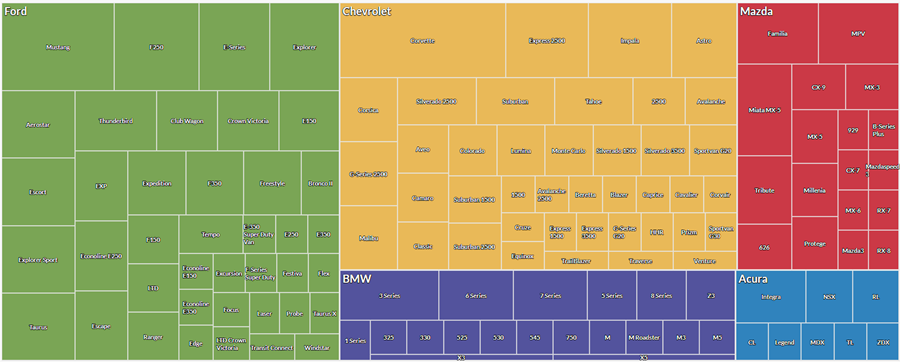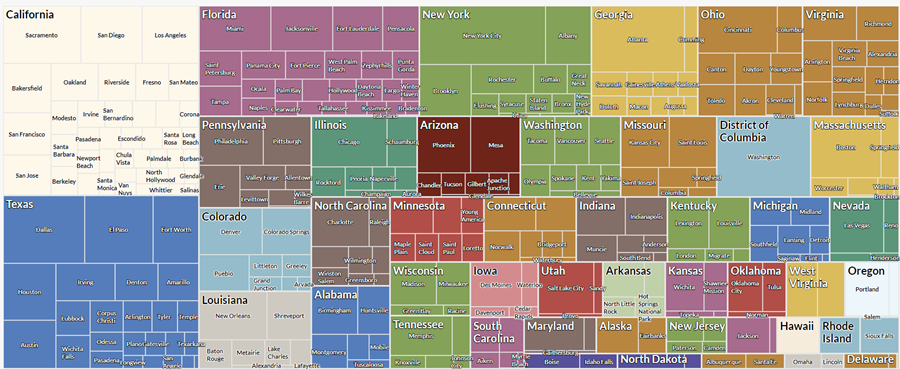Treemap chart
Treemaps display hierarchical, tree-structured data as a set of nested rectangles. Each group is given a rectangle, which is then tiled with smaller rectangles representing sub-groups. Size and color are used to show separate numeric dimensions of the data.
When do you use it?
Use treemaps when working with large amounts of data that is hierarchically structured. When color and size are correlated, treemaps can help identify patterns that would otherwise be difficult to see.
Treemaps are also effective at legibly displaying large volumes of information in a single screen. Viewers can then drill into a specific category to explore further.
Note
Treemaps support up to two levels of grouping at this time.
Examples
Car makes and models
You have a table that contains an inventory of cars. You want to visualize the count of car models within each make to get an overview of the inventory.
To visualize this data, you use a treemap and:
- group the data by make, and then by model
- set Size by to the count of vehicles
Based on the results, you can see how the inventory is distributed across makes and models:

Transaction totals by state and city
You have a table that contains transactions across multiple states and cities in the United States of America. As part of your analysis, you want to visualize the total transaction amount by state and by city within each state.
To visualize this data, you use a treemap and:
- group the data by state, and then by city
- set Size by to the sum of transactions
Based on the results, you can see a pattern start to emerge for the aggregate transaction amount within these groups:

Transaction counts and totals by state and city
You have a table that contains transactions across multiple states and cities in the United States of America. As part of your analysis, you want to visualize the count of transactions and the total transaction amount by state and by city within each state.
To visualize this data, you use a treemap. You group the data by state, and then by city. You also use the following additional settings:
- Size by count
- Color by sum of transactions
Based on the results, you can determine how transactions are distributed across different city and state combinations, and see a pattern start to emerge for the aggregate transaction amount within these groups:

Data configuration settings
-
From the Platform home page (www.diligentoneplatform.com), select the Results app to open it.
If you are already in Diligent One, you can use the left-hand navigation menu to switch to the Results app.
Note
Diligent One Platform also supports the domain www.highbond.com. For more information, see Supported domains.
- Navigate to the appropriate table.
- On the Configure
 panel, click Data and configure the following settings:
panel, click Data and configure the following settings:
| Setting | Supported data types | Description |
|---|---|---|
| Group |
|
The fields to use as categories. The second group you select is nested within the first group. Groups are displayed as rectangles. You can select a maximum of two groups. |
| Size by | numeric |
The aggregate value that determines the size of each group. You can select a count of records or one of several aggregate values for a numeric column in the table:
Tip You can control decimals and rounding on numeric data by changing format of this field. For the Average aggregate option, Format options is available in the Data tab of the Configure Visualization panel. For all other aggregate options, format options set in Table View is applied. For help doing this, see Data formatting options. |
|
Color by optional |
numeric |
The aggregate value that determines the color intensity, or scale, of each group. You can select a count of records or one of several aggregate values for a numeric column in the table:
Tip You can control decimals and rounding on numeric data by changing format of this field. For the Average aggregate option, Format options is available in the Data tab of the Configure Visualization panel. For all other aggregate options, format options set in Table View is applied. For help doing this, see Data formatting options. |
|
Format options |
numeric |
Select an option in this field to apply formatting such as decimals and rounding to the Y-axis values in the chart. For help doing this, see Data formatting options. Format options is available only for the Average aggregate option. For all other aggregate options, format options set in Table View is applied. |
Chart display settings
-
From the Platform home page (www.diligentoneplatform.com), select the Results app to open it.
If you are already in Diligent One, you can use the left-hand navigation menu to switch to the Results app.
Note
Diligent One Platform also supports the domain www.highbond.com. For more information, see Supported domains.
- Navigate to the appropriate table.
- On the Configure
 panel, click Display and configure the following settings:
panel, click Display and configure the following settings:
| Setting | Description |
|---|---|
| Options | |
| Show Legend | Show or hide the legend at the top of the chart. |
| Boost performance |
Switches into performance mode when data points on the chart go beyond 150 by applying some trade-offs. For more information, see Boost performance of charts. |
| Group Labels | |
| Show First Group | Include labels for values in the first group. |
| Show Second Group | Include labels for values in the second group. |
| Other settings | |
| Colors |
The colors assigned to:
|